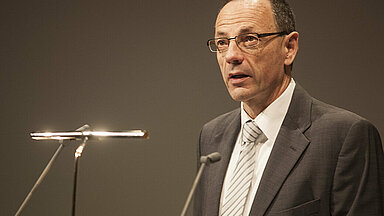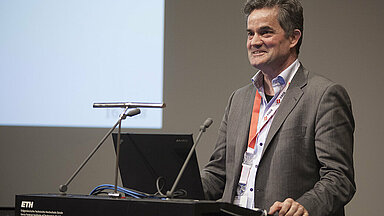June 17, 2015 - by Simone Ulmer
The challenges of big data and data storage were the hot topics at the second annual PASC Conference (PASC15), which took place from the 1st to 3rd of June at ETH Zurich. Over 350 attendees – around 100 more than at last year’s inaugural event – convened in Zurich to exchange ideas and experience. On the first two days, attendees participated in twenty mini symposia – comprising more than a hundred talks – in the fields of climate and weather, solid earth dynamics, life sciences, materials, physics, computer science and mathematics, and engineering. These disciplines all have one thing in common: the need to analyse and store the vast quantities of data being generated by the ever more accurate and higher-resolution simulations in today’s era of petascale computing.
The economic sciences – an emerging domain in HPC A new addition to this year’s conference programme was a mini symposium on “emerging domains” in scientific computing. One such domain, economics, is becoming more dependent on supercomputers to simulate the increasingly complex models from financial markets. In this context, the Nobel prize-winning economist Thomas Sargent from the University of New York was invited to give a public lecture on computational challenges in macroeconomics. Sargent pointed out that the use of high-performance computing in economics is still very much in its infancy – and that he was there not so much to lecture, but rather to listen, and learn.
Monday’s plenaries were given by astrophysicist Volker Springel and climate scientist Bjorn Stevens. Springel, at the University of Heidelberg, showed highly complex simulations of the universe through the aid of some exceptionally impressive visualisations. Bjorn Stevens, from the Max Planck Institute for Meteorology, then stunned the audience with his assertion that “the climate system is not computable.” He demonstrated this by revealing just how many of the equations and variables that influence the climate system are still unknown in climate models, before walking the audience through an example of how mixing and microphysical processes influence cloud structure and rainfall. What is often forgotten, explained Stevens, is that climate models are no substitute for understanding the climate system. Rather, they are a tool to understand it better.
The first day of the conference concluded with a poster session, with prizes awarded for the best posters in each of the scientific disciplines showcased at the conference.
Day two was all about materials science, opening with a plenary talk from Giulia Galli. The renowned materials scientist, who lectures at the University of Chicago, uses supercomputers to simulate the properties of novel materials that might one day be produced in the laboratory. For instance, these materials could produce more efficient solar cells or could be used in future microelectronics hardware.
The final day, featuring twenty-one contributed talks, was rounded off with invited talks from Jacqueline Chen from Sandia National Laboratories, Livermore, USA – an expert in the simulation of turbulent combustion – and David Keyes, Director of the Extreme Computing Research Center at King Abdullah University of Science and Technology, Saudi Arabia.
To see the videos of the Invited Plenary presentations please visit www.pasc15.org.
Availability of a wide range of architectures
As was the case at last year, the CSCS User Meeting was held on the Tuesday afternoon of the conference, giving CSCS Director Thomas Schulthess and his team the opportunity to bring the CSCS user community up to speed with the latest developments at the centre. Following the decommissioning of the supercomputer Monte Rosa in the spring, a universal computing platform is now available in Piz Daint-Piz Dora. To complement the resources available at CSCS, Schulthess encouraged researchers to apply for additional computing allocations through the European project PRACE II (Partnership for Advanced Computing in Europe): the second phase of PRACE gets underway at the end of 2016. He then reiterated the importance of investing in application software alongside hardware investments: this was one of the key motivations behind the formation of PASC and its predecessor project HP2C.

















